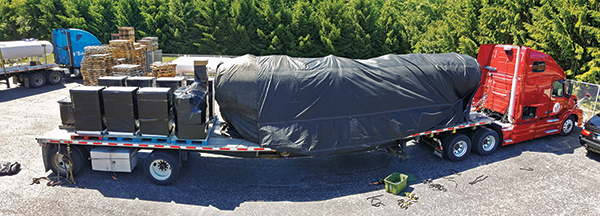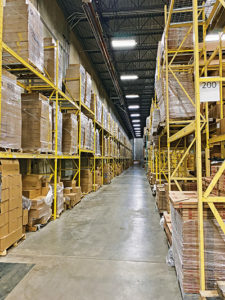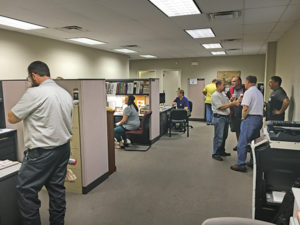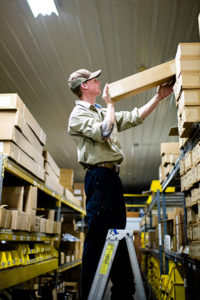Distributor roles, relationships with marketers evolve
This article discusses the roles and processes of equipment distributors in the propane industry and doesn’t reflect potential changes due to the COVID-19 coronavirus. Please check with your distributor for any modified operating procedures during this time.

The industry’s distributors supply not only equipment but also technical support and training to propane marketers. Photo courtesy of Bergquist
Equipment distributors serve as a well-traveled avenue for busy propane marketers working hard daily to meet the ever-growing needs of their customers.
In some ways, the roles of distributors and the type of equipment they offer to marketers have remained the same over the years.
“A flare nut in 1970 is still pretty much the same as a flare nut in 2020,” says Don Montroy of Bergquist Inc., a wholesale equipment distributor based in Toledo, Ohio.
But a closer look at distributor dynamics also reveals changes related to developing technologies and high expectations to provide equipment, knowledge and support for propane marketers in an efficient and timely manner.
One could call equipment distributors a “one-stop shop” for everything a propane marketer requires to run the business. That means providing the necessary customer service, inventory, technical support and training to keep propane marketers operating at full strength, especially during busy winter months.
“The distributors are the superhighway of the industry,” says Ray Kazakewich of R.E. Michel Co., based in Glen Burnie, Maryland.
Essentially, they provide sales and warehousing functions for propane equipment manufacturers, as distributors often carry a variety of diverse equipment, says Montroy.
But that’s not all.
“Distributors are also an extremely important asset to the industry for product information, codes and laws, industry news and new products,” says Kim Godlewski of IPS Equipment Inc. in Byron, Michigan, noting how distributors are also members of state and national associations and are involved on industry committees and task forces.
The role equipment distributors play in the propane industry has gained in importance over the years, Godlewski says, with marketers needing to get “what they want, when they want it.”
Kazakewich adds, “A lot more is expected of distributors now than at any time in the history of the industry. … Now the role is based more on the process of the partnership, which includes a bigger role in the success of the customer. There is no 9 to 5 anymore; those days are long gone.”
Staying in contact
Propane marketers ready to stock their businesses with new parts and equipment have a variety of ways to communicate with distributors and follow through on their product needs.
The evolution of communication methods is one example of how technology has changed the equipment distribution business.
The traditional methods of customers perusing printed catalogues, calling or faxing orders, driving to pick up their orders or placing orders at the counter still exist today. However, Matt Rannou of MTankCo Supply, a subsidiary of Mississippi Tank Co., says the buying and selling process “has changed drastically,” with myriad communication methods available and providing added flexibility and simplicity for the customer.
Customers now can submit orders online. They’ve visited the company website or browsed an online catalogue, and can follow through with a digital purchase or an email. Companies like MTankCo even allow customers to text their orders.
“The web-based portion of our business is the fastest-growing customer segment and has been for the past 10 years,” says Kazakewich. “Web-based orders are larger, on average, with more product adjacency, and are usually placed long after our business has closed for the day.”
Likewise, before the sale ever takes place, distributors must communicate their offerings and solutions to propane marketers. Distributors use a variety of ways to stay in contact today, including telephone calls, email blasts, digital newsletters and social media.
“Effective communication is an absolute need to keep marketers informed of available equipment and services,” says J.R. Anderson of Gas Equipment Co. Inc. in Dallas.
Of course, industry relationships are formed and nurtured through years of face-to-face meetings, whether at industry events or by visits from traveling sales representatives who share brochures that feature the company’s latest technology. Some equipment distributors facilitate these personal connections across industry segments by holding their own open houses, which often have a trade-show feel with tabletop exhibits and social and recreational events.

Despite the growth of digital communication, face-to-face meetings remain critical. Photo by LP Gas staff
“I think equipment distributors today work more closely with customers and manufacturers to bring innovative products and services to the propane industry,” Montroy says.
LPG & NH3 Supply Inc. finds that most of its customers would rather speak to a member of the sales team so they can ask questions about products or get help with installations, says the Minnesota-based company’s Charlie Koch. Its outside sales team travels full time, calling on customers at least every seven weeks and serving as a source of information on new products and everyday support.
“Most distributors have an outside sales force that call on marketers directly and are there to support when needed for product training or any product issues,” Godlewski says.
High-tech efficiencies

Technological advancements have streamlined inventory control and order entry, and have enabled troubleshooting in the field. Photo courtesy of LPG & NH3 Supply
In addition to communication benefits, technology has helped distributors gain operational efficiencies in areas like inventory control and order entry programs. Where orders and shipping used to be done mainly by hand, now most everything today flows seamlessly through the system, Godlewski says. This allows distributors to provide a timely response to customers’ needs.
“It’s our goal to keep ample inventory on all standard propane equipment items and ship it out the same day it’s ordered,” Montroy says.
Technology also allows for the troubleshooting of parts and equipment or addresses a situation in the field.
“A technician can immediately text a picture or video showing a problem they are having or questions they have,” Godlewski says.
Koch says the same process is happening at LPG & NH3 Supply, as many of its customers are FaceTiming with the sales team when questions about an install or product arise.
“They are able to FaceTime and show our salesman exactly what they are talking about, and it seems to work very well,” he adds.
Even before technicians get to the field, the way they train and learn about products “has evolved from printed materials to face-to-face training classes to recorded and posted digital videos accessible with common mobile devices almost anywhere,” Anderson says.
Equipment trends

Some distributors build personal connections across propane industry segments by holding their own open houses. Photo courtesy of Bergquist
While much of the propane equipment has remained the same over the years – “Why change something that’s already so good,” Koch says – some distributors still cite changes in product offerings and new ways propane marketers and the industry can benefit.
Bergquist says low-emission valves are available for liquid transfer. Less-expensive communication technology has allowed for the growth in products like remote tank monitoring, and the “internet of things” will help facilitate more changes in propane equipment in the not-too-distant future, it adds.
“The equipment has changed to make all types of propane systems safer,” Godlewski says. “Safety, particularly at transfer facilities, has greatly improved with new valve and safety designs. Product flow rates [also] have increased to make transfer times more efficient.”
Other equipment has evolved as the needs of the propane industry have changed, says Anderson.
“I would say the greatest change has been to enhance safety of storage, transfer and utilization of propane,” Anderson adds. “The second motive has been to reduce fill and delivery times by bobtails, which impacts storage and truck pumps and compressors, metering systems, piping and equipment used in the transfer operations, followed by increased efficiencies of electronic control and mobile accounting and computing systems.”
Kazakewich says it’s important for distributors to recognize the difference between “a blip and an actual trend” when it comes to equipment changes in the industry.
“Every now and then a big change happens within a particular space and we have to identify it quickly,” he adds.
Just as distributors must survey the landscape of new products and equipment, they also continue to take notice of a changing industry and the makeup of their marketer customers.
“The industry and its marketers are a diverse group that is evolving as new generations take over those businesses,” Anderson says.

















